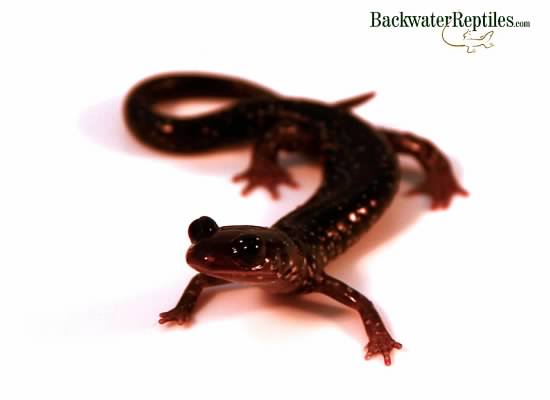Salamanders can make rewarding and entertaining pets. They are hardy little creatures, have cute features, and live long lives for such small animals.
Interested in getting a pet salamander for yourself or your family? Wondering where to begin or what species is good to start out with? Well then, read on! We put together this simple list all about which salamander species make the best pets just for you!
5. Slimy Salamander (Plethodon glutinosus)
A better name for the Slimy Salamander might actually be the “Sticky Salamander.” While all salamanders are generally moist to the touch, the Slimy Salamander can leave a glutinous, clingy clear substance on your hands if you handle it. The substance, while annoying, is not at all harmful to people, but some might find it off-putting. This is the reason why we’ve had to put the Slimy Salamander at #5 on our list.

Besides their stickiness, Slimies can make great little pets. They have minimal care requirements and can be kept in an enclosure as small as a plastic shoe box. They eat small invertebrates like crickets and will spend most of their time hiding, so be sure to provide a hide spot or two.
4. Fire Salamander (Salamandra salamandra)
Fire Salamanders are stunning little amphibians. Their skin is dark black and is accented with bold, yellow blotches and stripes. Most will have spots on their backs, but some can have more yellow on their top sides/backs than black.
These salamanders are known as being the first species of salamander described taxonomically and will grow to lengths of up to twelve inches. It has been reported that they can live to be ten years old in captivity.

Fire Salamanders are actually not burrowers like most salamanders, so they can do just fine on a substrate of moist paper towels, however most hobbyists enjoy creating natural-looking habitats, so they will also thrive on any typical salamander substrate that retains moisture well.
Feeding your Fire Salamander is simple. Their food of choice is night crawlers, AKA earth worms. Interestingly enough, if your salamander is small, you can even cut the worms up into pieces and the salamander will still eat it. This is uncommon for salamanders as most will need to see live insects wriggling, crawling, or hopping in order to recognize them as food.
3. Marbled Salamander (Ambystoma opacum)
Marbled Salamanders have chunky bodies with shorter limbs (at least when compared directly with other salamanders). They have black bodies with contrasting white or grayish colored bars and stripes on their backs and heads.

These are considered medium-sized salamanders and will grow to be around 5 inches long. They are also very avid burrowers. If you provide a substrate that supports burrowing, be aware that you will rarely see your pet salamander. In fact, Marbled Salamanders spend so much time burrowed underground that they have been nicknamed “mole salamanders.”
2. Spotted Salamander (Ambystoma maculatum)
Of all the salamanders available in the pet trade, the Spotted Salamander is the least common. This is not because it is endangered, hard to keep, or expensive to buy – it’s simply because they have sort of a “cult following.” People who have kept them before sing their praises, but people who are not familiar with them probably don’t know much about them.

Spotted Salamanders are another medium-sized amphibian. Adult females can grow as large as ten inches long, although six to seven inches is a more common size. Males are also noticeably smaller than the females.
People who keep Spotted Salamanders as pets are usually initially attracted to the animal due to its vibrant combination of yellow and/or orange spots on its back.
1.Tiger Salamander (Ambystoma tigrinum)
Tiger Salamanders are number one on our list because of how readily available they are. This means that any tiger salamanders available in the pet trade are most likely captive bred animals reducing or altogether eliminating any internal parasites that wild-caught animals might carry. Their care requirements are also widely known meaning that even large pet stores know at least the basics of caring for these amphibians.
Tiger Salamanders are the largest of the salamanders on our list of best pet salamanders. They can grow to be as big as 14 inches long.

They have very healthy appetites and will almost always eat anything you offer them. Some of the larger ones will even eat pinkie mice. They can even be trained to accept food from their owner’s hand.
Of all of the salamander species on this list, Tiger Salamanders are also the least secretive. They will be the most interactive and adapt to being handled easier than any other species, making them overall a heartier pet, especially if you expect your pet salamander to “play” with children.
Conclusion
Overall, salamanders are good pets because they are very good-natured amphibians. They tend to keep to themselves and will never bite or unintentionally harm their owners. They can be delicate however, and most are somewhat secretive, so if you are seeking a highly interactive pet, you might want to consider a reptile over an amphibian.
Ready to commit to a pet salamander? Backwater Reptiles has all of the salamanders for sale that are named above in our list.

